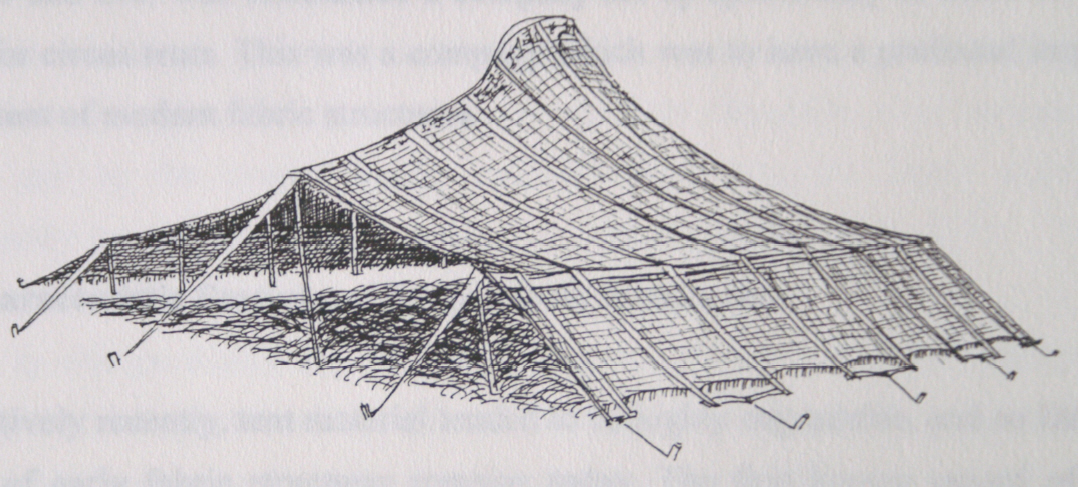Shelter

|
| Black tent |
Contents |
[edit] History
Very broadly, shelters provide physical protection from something that is potentially harmful.
Remains have been found of simple structures constructed from animal skins draped between sticks dating back over 40,000 years, and it is likely these were the first type of shelter constructed by humans.
Simple tents suited a nomadic lifestyle. Lightweight and easy to carry, they could be moved from place to place in harsh environments where it was necessary to keep on the move to stay alive. Where resources were more plentiful, it was possible to settle down and build permanent shelters in the form of huts. In intermediate environments, a whole range of composite structures developed, part tent, part hut, most notably the Yurt, a demountable hut, still in use in places such as Mongolia today.
This combination of a fundamental requirement for shelter, moderated by practicality and resource availability, still drives the design of our buildings today, and can be seen in as varied typologies as the Troglodytic architecture of sculptured hillside landscapes in Morocco, to the Eskimos’ igloos, to Malaysian tree-dwelling, African courtyard houses, and the English thatched cottage.
[edit] Function
Very broadly shelters might be required to provide:
- Privacy.
- Security.
- Cover from the sun, rain, wind, snow and so on.
- Control of temperature, air movement, humidity, air quality, noise and so on.
- A status symbol.
- A meeting point.
- Permanent or temporary accommodation.
[edit] Other types of shelter

|
| A bothy in the Scottish Highlands. |
- Air-raid shelter: used for protecting civilian and military personal from bomb attacks. They may be improvised from existing structures eg, London Underground tunnels or be specially designed.
- Animal shelter: provides a home (usually temporary) for abandoned or lost animals.
- Bivouac shelter (British: ‘bivvy’ for short): this is usually a temporary shelter of any lightweight construction used by mountain climbers or scouters. They may construct a bivouac shelter from branches and leaves. A bivouac sack often used by mountaineers and army personnel is a small, lightweight, waterproof bivouac shelter that may comprise a simple covering over a sleeping bag and can fit easily into a backpack.
- Blast shelter: provides protection from blasts and explosions from weapons.
- Bothy: a small shelter that has been restored from a ruinous condition to provide basic, temporary accommodation to passers-by, such as hill walkers. Usually unlocked, they are typically made of stone, have a pitched roof and are particularly common in the Scottish Highlands and other upland areas of the UK.
- Bus shelter: provides protection from wind and rain while awaiting the arrival of a bus.
- Canopy: An overhead roof structure that has open sides. Canopies are typically intended to provide shelter from the rain or sun, but may also be used for decorative purposes, or to give emphasis to a route or part of a building.
- Emergency shelter: provides temporary shelter for people when their homes have been partially or permanently affected by various phenomena including floods, earthquake, explosions, avalanches, social unrest, war and so on.
- Fallout shelter: provides protection from radiation such as that which might occur as a result of nuclear explosions or nuclear accidents.
- Homeless shelter: provides a temporary bed and washing facilities to those who might otherwise have to sleep on the streets.
- Refuge: a special cabin used in underground construction into which workers may retreat in the event of an emergency, eg a gas leak or rock fall, where they remain until help arrives. Refuges are usually stocked with oxygen, water and other basic provisions.
- Rock shelters: natural formations in cliffs where softer rock has been eroded over time to form a type of cave that may provide shelter from the elements.
- Ramada: a shelter with roof and no walls that is constructed from branches or bushes for the sole purpose of providing solar protection. Ramadas may be temporary or permanent and are found mainly in the southwestern USA. Modern varieties may also be built with commercially available construction materials.

|
[edit] Related articles on Designing Buildings Wiki
- Adobe.
- Cob building.
- Construction materials.
- Earthen construction.
- Emergency healthcare architecture in Brazil.
- Fabric structures.
- Green building.
- Managing and responding to disaster.
- Practical Building Conservation: Earth, Brick and Terracotta.
- Resilience.
- Roof.
- Sheltered area.
- Smoking shelters.
- Types of building.
Featured articles and news
Wellbeing in Buildings TG 10/2025
BSRIA topic guide updates.
With brief background and WELL v2™.
From studies, to books to a new project, with founder Emma Walshaw.
Types of drawings for building design
Still one of the most popular articles the A-Z of drawings.
Who, or What Does the Building Safety Act Apply To?
From compliance to competence in brief.
The remarkable story of a Highland architect.
Commissioning Responsibilities Framework BG 88/2025
BSRIA guidance on establishing clear roles and responsibilities for commissioning tasks.
An architectural movement to love or hate.
Don’t take British stone for granted
It won’t survive on supplying the heritage sector alone.
The Constructing Excellence Value Toolkit
Driving value-based decision making in construction.
Meet CIOB event in Northern Ireland
Inspiring the next generation of construction talent.
Reasons for using MVHR systems
6 reasons for a whole-house approach to ventilation.
Supplementary Planning Documents, a reminder
As used by the City of London to introduce a Retrofit first policy.
The what, how, why and when of deposit return schemes
Circular economy steps for plastic bottles and cans in England and Northern Ireland draws.
Join forces and share Building Safety knowledge in 2025
Why and how to contribute to the Building Safety Wiki.
Reporting on Payment Practices and Performance Regs
Approved amendment coming into effect 1 March 2025.






















